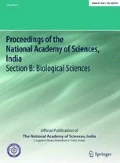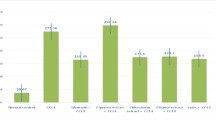Abstract
The study evaluated the hepatoprotective activity of plant extracts of cinnamon and glycyrrhizin in distinct dosage ways to minimize the oxidative stress induced by carbon tetrachloride (CCl4) in BALB/cJ inbred albino mice. Fifteen albino mice were divided into five groups, each group containing three mice. Group A was referred as positive control while group B, C, D and E were injected intraperitoneally with 1 mL/kg body weight of CCl4 twice a week for 1 month. Group C and D were treated orally with isolated extracts of cinnamon @50 mg/kg and glycyrrhizin @50 mg/kg respectively on daily basis for 1 month. However, group E was treated orally with combination dose of cinnamon @50 mg/kg + glycyrrhizin @50 mg/kg body weight. The increase in the levels of alanine transaminase (ALT), aspartate transaminase (AST) and alkaline phosphatase (ALP), triglyceride (TG), malondialdehyde (MDA) and glucose were recorded in CCl4 induced liver injury in mice while there is decrease in the levels of total protein (TP), reduced glutathione (GSH), Superoxide dismutase (SOD) and catalase (CAT) in CCL4 intoxicated mice. Isolated therapy of plant extracts of cinnamon and glycyrrhizin decreased the levels of ALT, AST, ALP, MDA, TG and glucose whereas increase in TP, GSH, SOD and CAT was observed in plant extracts treated mice. The best restoration of all the above said parameters near to control was observed in group of mice treated with combination dose of cinnamon and glycyrrhizin @50 mg/kg. Therefore, the present study declared the antioxidative, anti-inflammatory and hepatoprotective activity of standardized extracts of cinnamon and glycyrrhizin and their potent defensive property.

Similar content being viewed by others
Abbreviations
- CCl4 :
-
Carbon tetrachloride
- ROS:
-
Reactive oxygen species
- RNS:
-
Reactive nitrogen species
- ALT:
-
Alanine transaminase
- AST:
-
Aspartate transaminase
- ALP:
-
Alkaline phosphatase
- TG:
-
Triglyceride
- MDA:
-
Malondialdehyde
- TP:
-
Total protein
- GSH:
-
Reduced glutathione
- SOD:
-
Superoxide dismutase
- CAT:
-
Catalase
References
Malik A, Qureshi MS, Manan A, Saleem S, Munir M, Fatima A, Arooj M, Qazi MH (2013) Assessment of oxidative stress in hepatitis C patients receiving interferon therapy. Pak J Med Dent 2(04):10–15
Takte SB, Gite VN, Chopade VV, Pokharkar RD (2010) Hepato-protective activity of Launaea intybacea in carbon tetra chloride induced hepato-toxicity in albino rats. IJPRIF 2:266–268
Gurdip S, Kapoor IPS, Pratibha S, de Heluani CS, Marina PD, Cesar ANC (2008) Chemistry, antioxidant and antimicrobial investigations on essential oil and oleoresins of Zingiber officinale. Food Chem Toxicol 46(10):3295–3302
Kwon HK, Hwang JS, So JS, Lee CG, Sahoo A, Ryu JH, Jeon WK, Ko BS, Im CR, Lee SH, Park ZY, Kwon SH (2010) Cinnamon extract induces tumor cell death through inhibition of NF_B and AP1. BMC Cancer 24(10):392
Dugoua JJ, Seely D, Perri D, Cooley K, Forelli T, Mills E, Koren G (2007) From type 2 diabetes to antioxidant activity: a systematic review of the safety and efficacy of common and cassia cinnamon bark. Can J Physiol Pharmacol 85(9):837–847
Qin B, Panickar KS, Anderson RA (2010) Cinnamon: potential role in the prevention of insulin resistance, metabolic syndrome, and type 2 diabetes. J Diabetes Sci Technol 4(3):685–693
Moselhy SS, Junbi HH (2010) Antioxidant properties of ethanolic and aqueous cinnamon extracts against liver injury in rats. Int J Adv Pharm Sci 1:151–155
Kanuri G, Weber S, Volynets V, Spruss A, Bischoff SC, Bergheim I (2010) Cinnamon extract protects against acute alcohol-induced liver steatosis in mice. J Nutr Dis 139(3):482–487
Moselhy SS, Ali HK (2009) Hepatoprotective effect of Cinnamon extracts against carbon tetrachloride induced oxidative stress and liver injury in rats. Biol Res 42(1):93–98
Snow J (1996) Glycyrrhiza glabra monograph. J Bot Med 1(3):9–14
Fukai T, Baosheng C, Maruno K, Migakawa Y, Konoshi M, Nomura T, Cai B (1998) An isopernylated flavonone from Glycyrrhiza glabra and re-assay of liquorice phenols. Phytochem 49:2005–2013
Ross IA (1999) Medicinal plants of the world. Chemical constituents, traditional and modern medicinal uses, vol 2. Human Press, Ottawa, pp 623–628
Arystanova T, Irismetov TM, Sophekova A (2001) Chromatographic determination of Glycyrrhizinic acid in Glycyrrhiza glabra preparation. Chem Nat Compd 37:89–91
Isbrucker RA, Burdock GA (2006) Risk and safety assessment on the consumption of Licorice root (Glycyrrhiza sp.), its extract and powder as a food ingredient, with emphasis on the pharmacology and toxicology of Glycyrrhizin. Regul Toxicol Pharmacol 46:167–192
Yamamura Y, Kawakami J, Santa T (1992) Pharmacokinetic profile of Glycyrrhizin in healthy volunteers by a new high-performance liquid chromatographic method. J Pharm Sci 81:1042–1046
Hayashi J, Kashiwagi S, Noguchi A, Ikematsu H, Tsuda H, Tsuji Y, Motomura M (1989) Combination therapy of Glycyrrhizin withdrawal and human fibroblast interferon for chronic hepatitis B. Clin Ther 11(1):161–169
Akamatsu H, Komura J, Asada Y, Niwa Y (1991) Mechanism of anti-inflammatory action of Glycyrrhizin: effect on neutrophil functions including reactive oxygen species generation. Planta Med 57:119–121
Wang ZY, Nixon DW (2001) Licorice and cancer. Nutr Cancer 39:1–11
Ashfaq UA, Nawaz Z, Riazuddin S (2011) Glycyrrhizin as antiviral agent against hepatitis C virus. J Transl Med 9:112
Crance JM, Biziagos E, Passagot J (1990) Inhibition of hepatitis A virus replication in vitro by antiviral compounds. J Med Virol 31:155–160
Van-Rossum TG, Vulto AG, Hop WC (1999) Intravenous Glycyrrhizin for the treatment of chronic hepatitis C: a double-blind, randomized, placebo-controlled phase I/II trial. J Gastroenterol Hepatol 14:1093–1099
Rasool M, Iqbal J, Malik A et al (2014) Hepatoprotective effects of Silybum marianum (Silymarin) and Glycyrrhiza glabra (Glycyrrhizin) in combination: a possible synergy. Evid Based Complement Altern Med vol. 2014, Article ID 641597, 9 pages. doi:10.1155/2014/641597
Kakkar P, Das B, Viswanathan PN (1948) A modified spectrophotometric assay of superoxide dismutase. Indian J Biochem Biophys 21:130–132
Moron MS, Depierre JW, Mannervik B (1979) Levels of glutathione reductase and glutathione S transferase in rat lung and liver. Biochem Biophys Acta 582:67–68
Ohkawa H, Ohishi N, Tagi K (1979) Assay for lipid peroxides in animal tissues by thiobarbituric acid reaction. Anal Biochem 95:351–358
Aebi H (1974) Catalase. In: Bergmeyer HU (ed) Methods in enzymatic analysis, vol 3. Academic Press, New York, pp 276–286
Sherlock S, Dooley J (2002) Diseases of liver and biliary system, 11th edn. Blackwell Scientific Publications, Oxford, pp 322–356
Opoku AR, Ndlovu LM, Terblanche SE, Hutch AH (2007) In vivo hepatoprotective effects of Rhoicissus tridentata subsp. cuneifolia, a traditional Zulu medicinal plant, against CCl4-induced acute liver injury in rats. S Afr J Bot 73:372–377
Olukoga A, Donaldson D (1998) Historical perspectives on health. The history of liquorice: the plant, its extract, cultivation, commercialization and etymology. J R Soc Health 118:300–304
Kiso Y, Tohkin M, Hikino H, Hattori M, Sakamoto T, Namba T (1984) Mechanism of antihepatotoxic activity of glycyrrhizin. I. Effect of free radical generation and lipid peroxidation. Planta Med 50:298–302
Acknowledgements
This research work was funded and supported by Institute of Molecular Biology and Biotechnology, and Department of Pharmacy, The University of Lahore, Lahore, Pakistan. This project was partially supported by the National Plan for Science, Technology and Innovation (MAARIFAH) – King Abdulaziz City for Science and Technology - the Kingdom of Saudi Arabia – award number (10-BIO1073-03, 10-BIO1258-03 and 08-MED120-03).
Author information
Authors and Affiliations
Corresponding author
Ethics declarations
Conflict of interest
The authors declare that they have no conflict of interest.
Ethical Standard
This research work is approved by local ethical committee of university and the authors further declare that presently this manuscript is not submitted to any journal for publication consideration.
Additional information
Significance Statement The present study evaluated the medicinal properties of glycyrrhizin and cinnamon extracts and found that they possess the antioxidative properties that help in the recovery of liver injury by lowering the lipid peroxidation and stabilizing the altered serum biomarkers.
Rights and permissions
About this article
Cite this article
Rasool, M., Malik, A., Saleem, S. et al. Assessment of Circulating Biochemical Markers in Mice Receiving Cinnamon and Glycyrrhizin Under Carbon Tetrachloride Induced Hepatic Injury. Proc. Natl. Acad. Sci., India, Sect. B Biol. Sci. 89, 105–111 (2019). https://doi.org/10.1007/s40011-017-0920-6
Received:
Revised:
Accepted:
Published:
Issue Date:
DOI: https://doi.org/10.1007/s40011-017-0920-6




